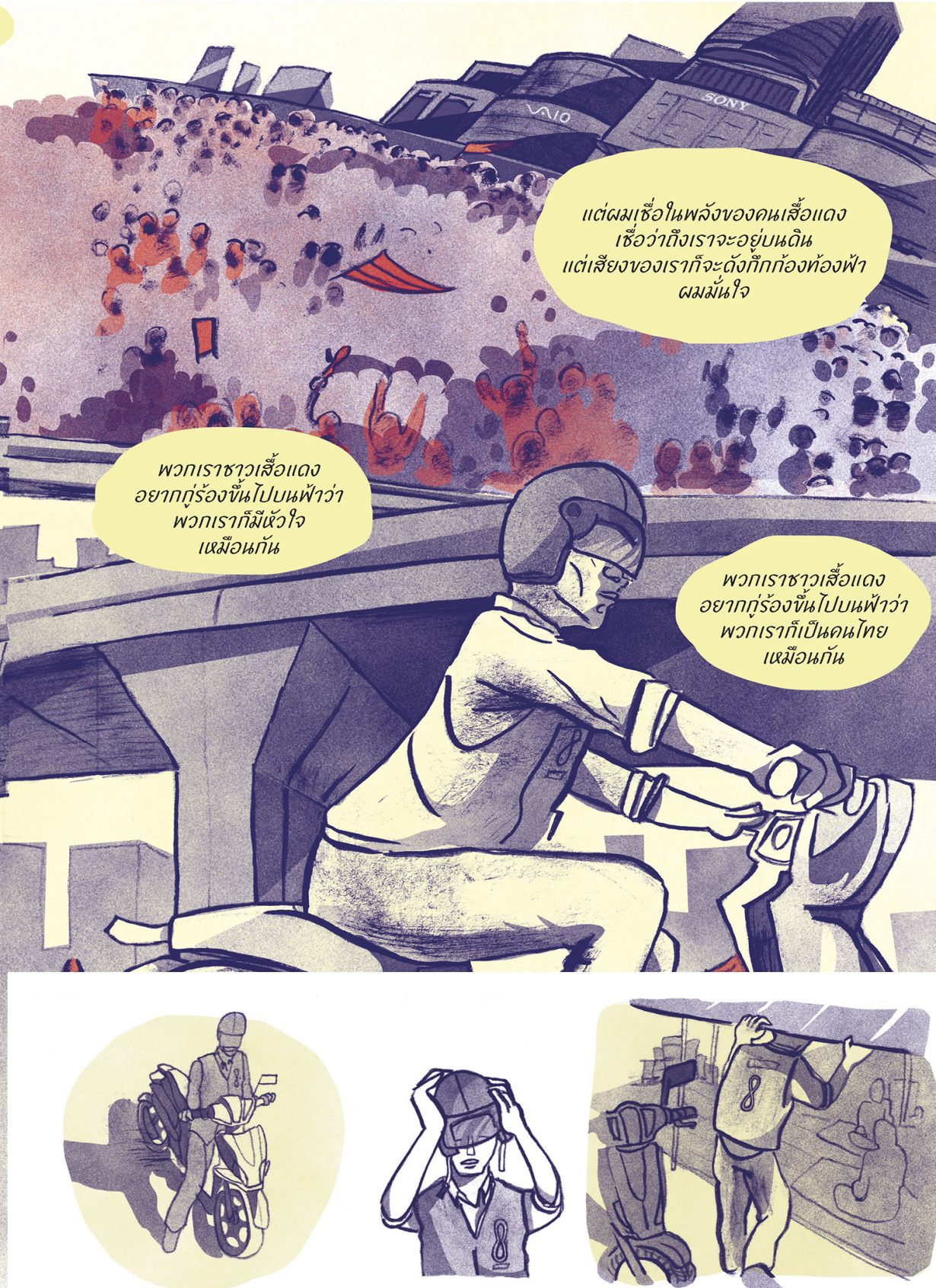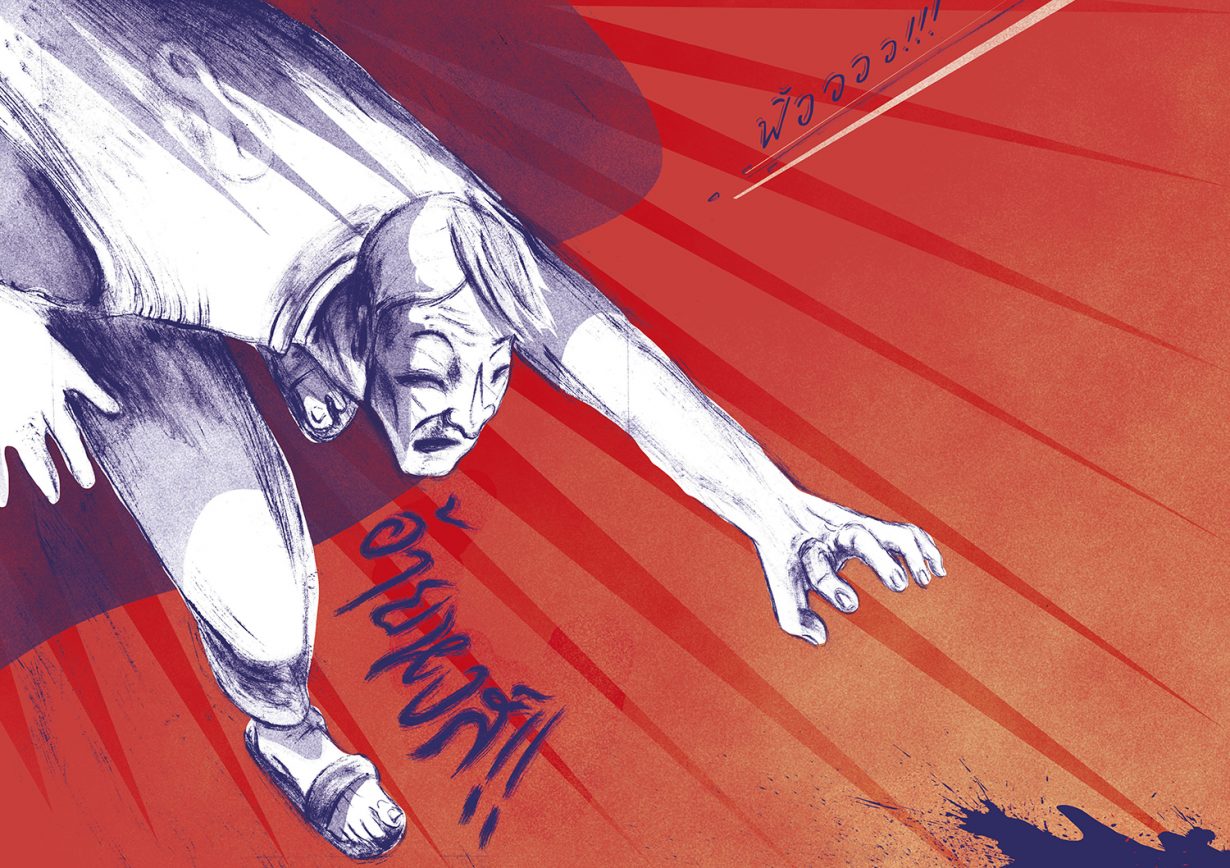A political history of the city’s striving ‘moto-sai’ – the thousands of rural-to-urban migrants who weave through the Thai capital’s teeming lanes
My favourite motorcycle taxi driver is easy to spot. His light-red vest immediately marks him out as the rebel among the half-dozen drivers who wait for passengers at the tip of my soi, one of the many thousands of slender back-roads branching off Bangkok’s thoroughfares. In contrast to his colleagues’ hi-vis orange vests – which sport a photo id and queue number on the front and rear, as per municipal law – his is faded, unmistakably his. Written neatly on the back in white Tip-Ex is a slogan that reads: ‘Damri’s Struggle Dictatorial Regime’. And painted on the shoulders, left and right of this obscure reference to a barely remembered figure in Thailand’s defunct Communist Party, are two five-pointed stars – symbols of the awakened proletariat.
Over years of straddling his Honda and sitting close to him, of careening between cars and buses with him, of staring at this vest as we wait for lights to change, I’ve come to think of this sixty-something man less as an eccentric bit-player in the life of the city and more as the stoic epitome of the proudly provincial rural-to-urban Thai migrant. He is someone both drawn to and repelled by the economic machine of which he is a part, and someone who garners what little social capital he has, on the back-streets of Bangkok’s Sathorn district at least, by projecting an ideological backwardness.
But while his vest is, in my opinion, a badge of honour, a small display of power in the face of the city’s glossy affectations and autocratic edicts, there’s also a hint of the tragic about him. To me, he’ll also forever be the brazen pamphleteer who thrust a printed diatribe in my hand during the bloody denouement of the Red Shirt protests in May 2010, then raced off towards the columns of acrid black smoke, billowing from burning tires on nearby Rama 4 Road. During that convulsive time – broadcast on news networks around the world – he was a small yet spirited cog in a popular, labour-based movement fighting desperately to reinstall a government it believed valued the phrai (commoner) above the ammāt (aristocracy). A decade on from those ill-fated protests, he cuts a less formidable figure. No material changes to his circumstances are apparent. The red vest remains, but the exuberant hopefulness of that encounter has dissipated. As before, he continues to deftly navigate this scarred palimpsest of a modern city – but, socially and economically, he is now going nowhere fast.
Today, the kinetic joys of Bangkok’s motorcycle taxis are often extolled. ‘One of the unique experiences in Bangkok is hopping on the back of a motorcycle taxi – called moto-sai by Thais,’ writes one travel blogger. ‘Hop on, hold on and enjoy the ride!’ In popular culture terms, they are an emblem of the Thai street, up there with truck art, tuk-tuks and longtail boats, as well as a mainstay in sitcoms and even patriotic advertisements, where they now rival farmers and hilltribe people as stolid working-class archetypes. In contrast, however, the collective sense of self-respect, dignity and sociopolitical mobility that swelled among their unruly ranks during the late 2000s and early 2010s, then subsided, is not something to which many writers, filmmakers or artists are drawn. This is surely partly due to the fact that the moto-sai is an ancillary figure, a form of mass transit, about as visible to most middle-class Bangkok denizens as trains or buses – that is to say, only really noticed when they are broken somehow. Anecdotally, the recent headlines focusing on the turf wars between rival win (motorbike taxi-driver stalls), and the disruptive ride-sharing apps that have exacerbated them, bear this out. Then there is the political baggage that weighs this period down – it was Thaksin Shinawatra, the Chiang Mai policeman turned tycoon turned populist prime minister, who legitimised their informal economy and boosted their confidence in the years before and after he was ousted in the coup of 2006. True to form, Thailand is perpetually moulting such inconvenient truths.

and Chiara Natalucci, translated by Nuntawan Chanprasert and illustrated by Sara Fabbri
Ta Sawang (Il Re di Bangkok, 2020), a melancholic graphic novel written by Claudio Sopranzetti and Chiara Natalucci, and illustrated by Sara Fabbri, is one of the first creative endeavours truly to inhabit that time. Told through fevered flashbacks, the story blends typical comic-strip action with abrupt about-turns into freewheeling surrealism, all in an attempt to capture the joys and paroxysms of the disenfranchised rural-to-urban migrant trying to make ends meet. In its opening pages, our fictional male protagonist, Nok, arrives at Bangkok’s main train station, Hua Lamphong, from the northeast – the oft-belittled region from which the majority of the capital’s millions of internal migrants hail – only to quickly come a cropper. An amenable relative and a job in a shoe factory prove short-lived, and before long he’s sprawled on a bench, staring up wistfully at a billboard for Luk Isan (Son of the Northeast) as he pines for home.
This fleeting cameo by a social-realist film from 1982 belies the book’s ancestry – Ta Sawang is a similarly unflinching depiction of the struggles of the northeasterner. Against a shadowy backdrop of actual events – the 1997 financial crisis, Full Moon Parties, controversy over social critic Sulak Sivaraksa’s writings – Nok flits from jobs to romance to meth addiction to more destitution before finding, for a while at least, salvation of sorts: a bright orange vest that offers a chance at upward mobility, as well as a certain esprit de corps. Climaxing with a smouldering city and petrol bombs being flung over tire-ringed barricades, the story builds into a blood-flecked parable. Only when Nok is blinded by a bullet, while serving as a member of the Red Shirt movement’s guards-cum-cavalry, does he see the folly in putting yourself on the frontline for politicians.
Despite its moralistic tone and composite characters, Ta Sawang – which translates as ‘bright- eyed’ but is idiomatically closer to ‘seeing the light’ – has the ring of truth. For this it is indebted to Owners of the Map: Motorcycle Taxi Drivers, Mobility, and Politics in Bangkok (2017): Sopranzetti’s brilliant ethnographic study of their knowledge and awareness of the urban terrain, their political subjectivities and fragilities. In it, his years of assiduous research and oral interviews, partially gathered during the Red Shirt protests, are filtered through the official narratives of siwilai (civilisation) and phatthanā (development) that shaped both twentieth-century Bangkok and the Thais’ imagined spatial hierarchy – a conception that casts cities as aspirational, and regional towns and villages as ‘loci of uncivilized ways of life’, Sopranzetti writes.

and Chiara Natalucci, translated by Nuntawan Chanprasert and illustrated by Sara Fabbri
Early on, he gives a granular sociohistorical account of the four conditions of possibility that led to the emergence of the moto-sai during the early 1980s. The first was a mode of administration: the manner in which canny officials turned the amnāt (authority) deriving from their role in the state apparatus into itthiphon (influence) over the operations of the urban grey economy. The second: ‘millions of young and relatively unspecialized migrants from rural Thailand who, from the late 1950s, provided the city with cheap labor’. The third: ‘affordable motor cycles which flooded Thailand in the 1960s’. And the last: ‘a maze of disconnected and narrow soi that made motorcycle taxis indispensable for public transportation in the city.’
Sopranzetti also traces the heterogeneous forms of mobility unique to them. Through their nimble movement they ‘provide a functional – yet largely decentralized – infrastructure of transportation and delivery. An infrastructure as forgotten as the electric wires that hang over people’s heads or the pipes below their feet, yet as essential to the everyday life of a city that state-run mass transportation has failed to connect either spatially or socially.’
And even when seemingly idle, sitting not driving, they are building social networks. ‘Waiting’, Sopranzetti writes, ‘is a time for mapping the neighborhood around them, sustaining the channels through which their social relations with local state officials, street workers, and residents are forged, and attempting to make use of them to move up the social ladder.’ Life on the street is latent with transformative potential, both for the city and for themselves, ‘as they get accustomed to urban life, a trip at a time, its marvels and its sorrows, its excitements and its crushing oppression’. But it is also fraught with a risk that would seem to apply directly to my favourite driver: ‘Much like in their riding, however, taking these roads is always a gamble, one that can project the drivers into another life or keep them stuck in their place.’
Nearly 50 years ago, a similar sentiment was expressed in Prince Chatrichalerm Yukol’s Theptida Rong Raem (Hotel Angel), a classic social-realist film from the politically and socially tumultuous mid-1970s. About midway through it is a humdinger of a scene in which the viewer is tossed back and forth between footage of Malee – a naive country girl – entertaining a brothel customer in Bangkok, and footage of her father showing off the home paid for by her urban remittances. As she moves to unfasten her bra for yet another creepy punter, the camera skips, in the milliseconds before her breasts are revealed, to her father beaming as he proudly flings open the new terrace doors. “This house is what Malee has earned and sent us,” he tells the villagers huddled on the scorched grass out- side. “She’s doing well as a dressmaker.” This montage feels comically crass by today’s standards, but it does signpost the tears and tensions that have long existed between Bangkok – the avaricious beneficiary of the country’s internal colonialism – and a countryside that is perpetually feeding and imagining it.
My favourite driver makes me think about this, too. Sometimes, when riding behind him, I try to picture him back in his home in the northeast, when he’s not rocking that red vest, not breathing the polluted air, not barely surviving due to a faltering economy and mounting competition, not suffering the daily toll of a city that promises so much but surrenders so little. Does he boast of Bangkok, spin yarns, fuel desires? Does he bitterly curse it? And who, if anyone, listens?
